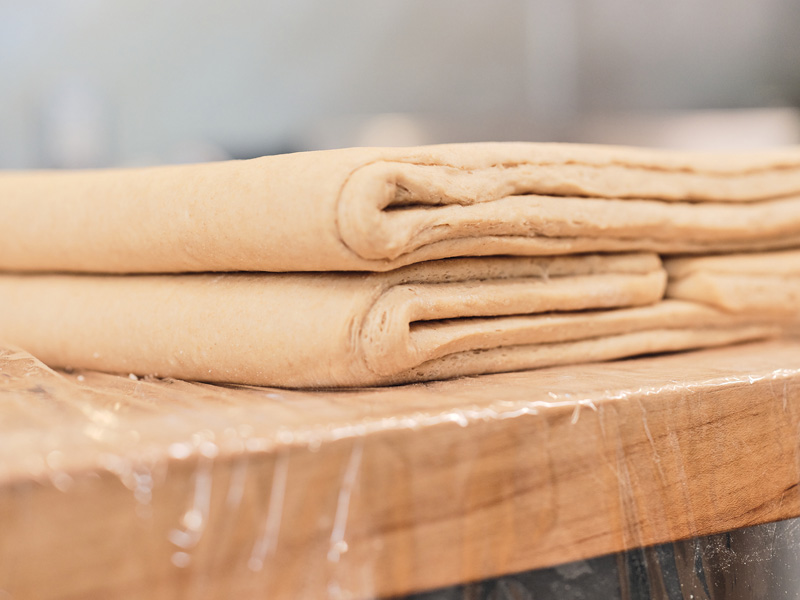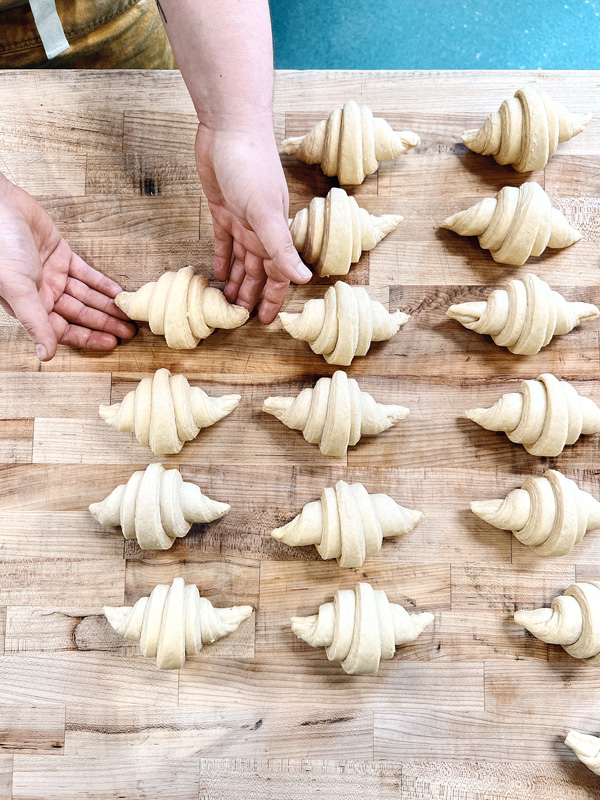Making croissants at the Grey Barn Dairy and Farm takes precision. Each batch of dough takes exactly 12,000 grams of flour, and is mixed at 5 and a half minutes at one speed and then 2 and a half minutes at another speed. The blocks of dough are measured with a ruler, 20 inches wide and 52 inches long, and go through various stages of laminating and proofing, all timed and scheduled.
Opinions of what makes a good croissant, however, seem a lot more subjective.
“A good croissant is flaky, buttery, and light — you know,” says Leah Smith of West Tisbury, a frequent customer. “It’s the density and the taste,” says Korrie Larkin, adding whatever it is, “it’s worth the drive” from Edgartown.
There was some debate at the farmstand when the croissant recipe was updated last year. Owner Eric Glasgow says some people complained about the change, while others found them better. Everyone has different tastes, Glasgow concluded.

Grey Barn head baker Melissa Ruttan says there’s a saying in the baking world that the best croissants make the biggest mess of crumbs in your lap.
There are only six ingredients in the croissants: flour, butter, eggs, milk, yeast, and sugar. As the person that arrives each morning between 4:15 and 6:30 am to make the croissants, bread, and other pastry, Ruttan says she believes the quality of ingredients — especially the butter and flour — make the biggest difference. Vermont Creamery supplies their butter, and Ruttan loves the quality. “Grass-fed butter is the best butter to use. It has a certain pliability, and it has great flavor.”
All the bakery’s flour for both pastry and the bread comes from freshly milled grains from New England, part of a renaissance of regionally grown heritage grains. For the croissants, they use a combination of stone-milled, all-purpose flour from Ground Up, a new mill in Western Massachusetts, and a sifted wheat flour ground really fine from Maine Grains in Skowhegan.
“I’ve been working with Maine Grains at a couple of different bakeries, so I’ve worked with the product for about five years,” says the 27-year-old Ruttan. She explains that most commercial wheat producers sift all nutrients out and then add the bran back. With these fresh local New England grains milled traditionally, “all the oils and nutrients are kept inside the flour. It’s way more flavorful because it’s freshly ground, and it’s also more nutrient-dense.”
Grey Barn first started making croissants in 2019 when the bakery first got underway with baker Christian Walter, who began baking naturally fermented sourdough breads. The farm decided to try croissants as well. The lines started forming on Sundays, stretching in a “socially distant” pattern past the parking area into the lawn. Clearly, they had hit on a winner.
The bakery has since added two additional pastry workers and a larger automatic dough sheeter, an Italian-made, 507-pound piece of equipment. The upgrades allowed them to expand offerings and produce a good quantity of pastry each week last summer, in addition to the bread. The stand also stocks the farm’s organic raw milk, eggs, specialty cheeses, produce, and grass-fed beef and pork.
“I definitely think croissants are having their doughnut moment,” says Ruttan.
It’s a three-day process to make the croissants. The croissant dough is used for all the plain and filled croissants — Pain aux Raisin (a round pastry swirl filled with dried cherries, yellow raisins, and a light custard — my new favorite) and the lemon or cheese-filled Danish. The bakery display — always enticing — also includes other items like the popular kouign-amann, a crispy caramelized pastry, and a changing rotation of goods, with maybe a traditional crumb-topped coffee cake one weekend, or something inspired by what might be coming from the orchard or gardens. The morning I was taking notes, grower Ethan Buchanan-Valenti showed up with more rhubarb, turned recently into rhubarb hand pies and toasted almond spandeurs (a type of Danish) with rhubarb jam. A new cheese and ham croissant features their own cheese, and ham from their heritage pigs.

When Ruttan arrives for work on Wednesdays, she’s ready to take the croissant dough, made the day before and fermented overnight, and begin the lamination process, which is combining 3-pound flattened blocks of butter into each of the weighed-out sections of croissant dough. Many bakers do this step by hand, folding dough over the butter, rolling out, then folding more. The bakery at Grey Barn uses the new automatic sheeter for this step. Like a giant pasta roller, it allows croissants to be folded and refolded without changing the temperature of the buttery dough, creating a better product.
Melissa was hired at the bakery in April 2021, responding to an ad for a “lamination manager.” She moved to the Island after only visiting previously, and settled into farm housing with her partner Michael McManamy, a restaurant chef now also helping in the bakery.
Eight months into the job, she unexpectedly was offered the job of head baker, in charge of both pastry and bread.
“I was surprised Christian was stepping away from the bakery, but it made sense for where he was in his life, having a new baby,” says Ruttan. “I was excited to take on a new role and a new challenge.”
She took the new responsibility in stride, having already by age 27 worked in eight restaurants and five bakeries, including a semester in France, as well as Old World Bakery in Asheville, N.C., and Atticus Bakery in Connecticut.
Ruttan made her decision to become a baker when she was just 12, and her first bakery jobs were in high school. She said her father was a printer, and passionate about his work. She figured if she could find a career she enjoyed, she would not mind working.

She took culinary classes at Newton North High School, followed by four years in pastry arts at Johnson & Wales in Rhode Island, graduating in 2016. She made desserts as an intern under top Boston Chef Ken Oringer at Uni, and created desserts in jobs afterward at Mida and Tapestry, both in Boston. But she kept getting drawn back into pastry and bakeries.
“I loved the precision and the discipline,” she says. “I liked that it was scientific, so if something went wrong, I could always backtrack and figure out what happened.”
She’s joined in the Grey Barn bakery by pastry Chef Tricia Lutkins, who has worked at both the Orange Peel and Pie Chicks bakeries, at either end of the Island.
The morning I spent in the bakery, Ruttan and Lutkins moved seamlessly and steadily from one task to another. When I arrived around 8:15 am, they had already been working for close to two hours. In the hour and a half I was there, Ruttan shaped four blocks of dough, cut and rolled out sheet pans of plain croissants for Thursday’s baking, filled and rolled the chocolate croissants, made the Pain aux Raisin, and completed a few other tasks. During the same time, Lutkins zested a case of lemons, the smell of which permeated the room, made lemon curd, measured out the pastry crème filling for the raisin croissant, helped Ruttan fill the chocolate croissants, and mixed another batch of croissant dough with that 12,000 grams (about 26 pounds) of dough, to start the process again the next day.
In the next room, Talia Weingarten, a former chef at now shuttered Seaweed’s restaurant in Oak Bluffs, had been preparing bread for the farmstand. On the next day’s bread schedule would be the whole wheat boule, white wheat batard, and a loaf with ancient grain. At around 9:30, Talia made everyone a snack of bread toasted in the giant bread oven, topped with perfectly sliced avocado, olive oil, and salt. When I left around 10, they still had four more hours of work. And, I noted to myself, this is spring. They had not yet ramped up for the busy summer to come.
As I was leaving, after watching flour fly and smelling lemon zest, I muttered, “I’ll never look at the croissants the same way.”
Ruttan responded, “There’s a lot of love put into them.”
















